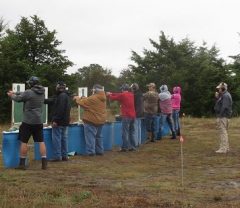by Sandy Keathley
Sight alignment is not the fundamental most ignored by shooters (I’ll come back to that on another post), but it is close. Many shooters, even reasonably good ones, treat sight-alignment as if it were a suggestion instead of a precision requirement. A basketball, for example, doesn’t have to go through a hoop of the exact same diameter as the ball; there is a margin for error of a few inches either way. Otherwise, we would not see any scores like 103. Suppose you had to hit a tiny hoop like that, not from the free-throw line, but from mid-court? Now you would begin to get it.
From 10 feet away, you can recognize the difference between a 5×8 photograph and an 8×10, but can you tell the difference between 1/4 inch and 3/8? When aligning the sights, it is relatively easy to get the top of the post level with the rear notch, but getting the white-space on either side of the post to be exactly equal is another thing. Yet, a discrepancy of 1/16 inch translates to 6 inches or more off the mark at 10 yards. And that doesn’t include muzzle drift caused by other factors. And it certainly doesn’t allow for the effects of aging eyes or progressive lenses. Yikes!
The greater the distance, the more precise that alignment has to be. Hitting a B-27 target at 3 yards doesn’t require the ultra-precise alignment of hitting a 3 inch circle at 15 yards; it’s all relative.
Nevertheless, becoming ultra-accurate at 7 yards requires concentration on small shot groups at 15 yards (or 25). As they say, “aim small, miss small“. I think working with small targets at increasing distances leads to greater success. When you have a gun with a laser on it, I have also found great benefit in trying to hold the laser on a spot the size of a dime while squeezing the trigger all the way to break. It is often frustrating, but tends to increase mental focus.
Most shooters know that you should focus on the front sight, and not the target or rear sight, yet I think many people underestimate the meaning of that word “focus” in this context. It doesn’t mean “look hard” at the front site, but rather to actually change the focal point of your vision, as if you no longer care about anything else. I think of it like a camera with a zoom feature. Focus on the front sight, but then try to zoom in on it. The goal is to make that sight crystal clear, to the exclusion of all else. No, that is not especially intuitive, and yes, it does make horizontal alignment more difficult, since the rear sight is now even less clear, but with practice you will learn which part of the fuzzy rear sight you need to align with. That just reinforces the value of working at shorter distances.
Zoom into the sight, and see how well you can pin-point your shots!
